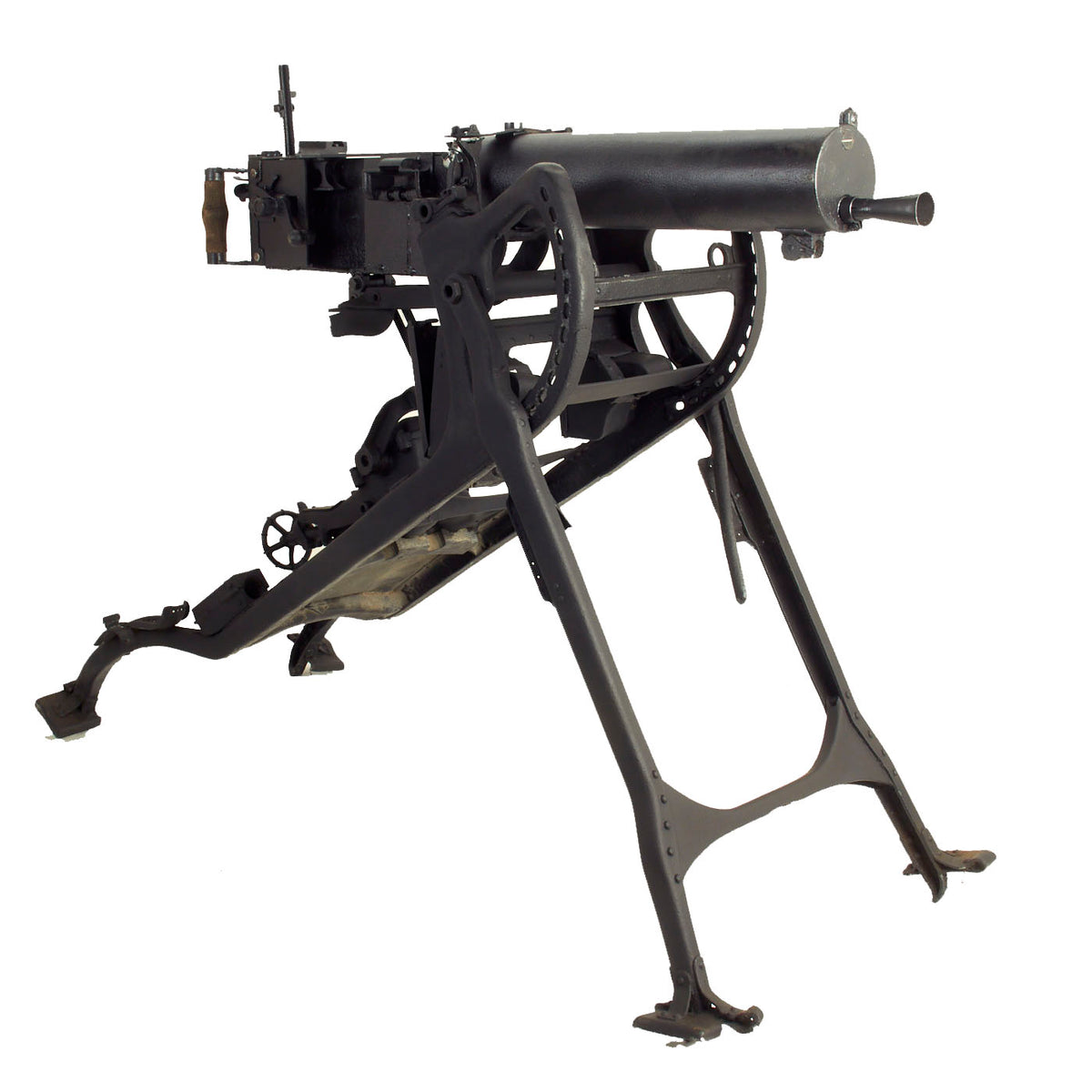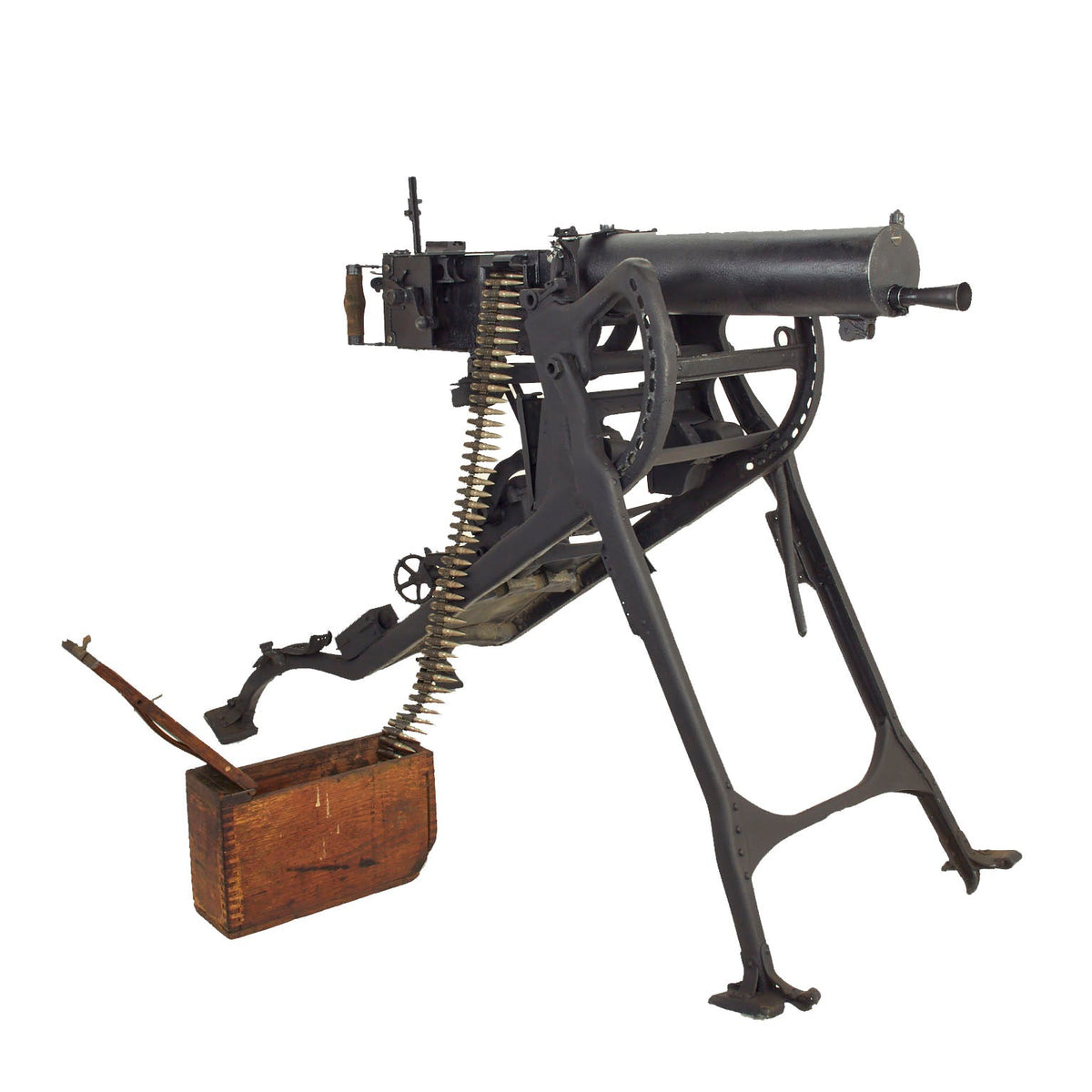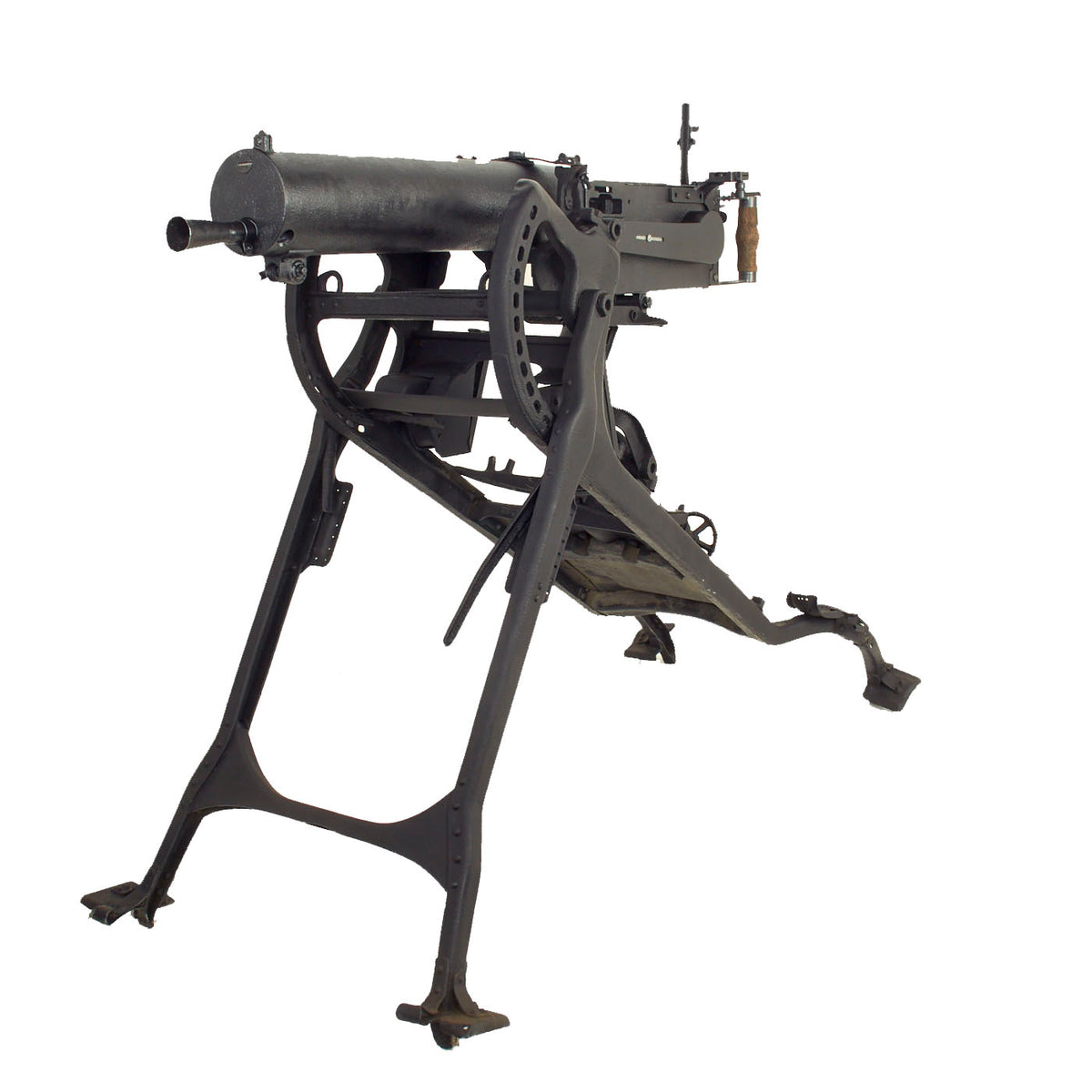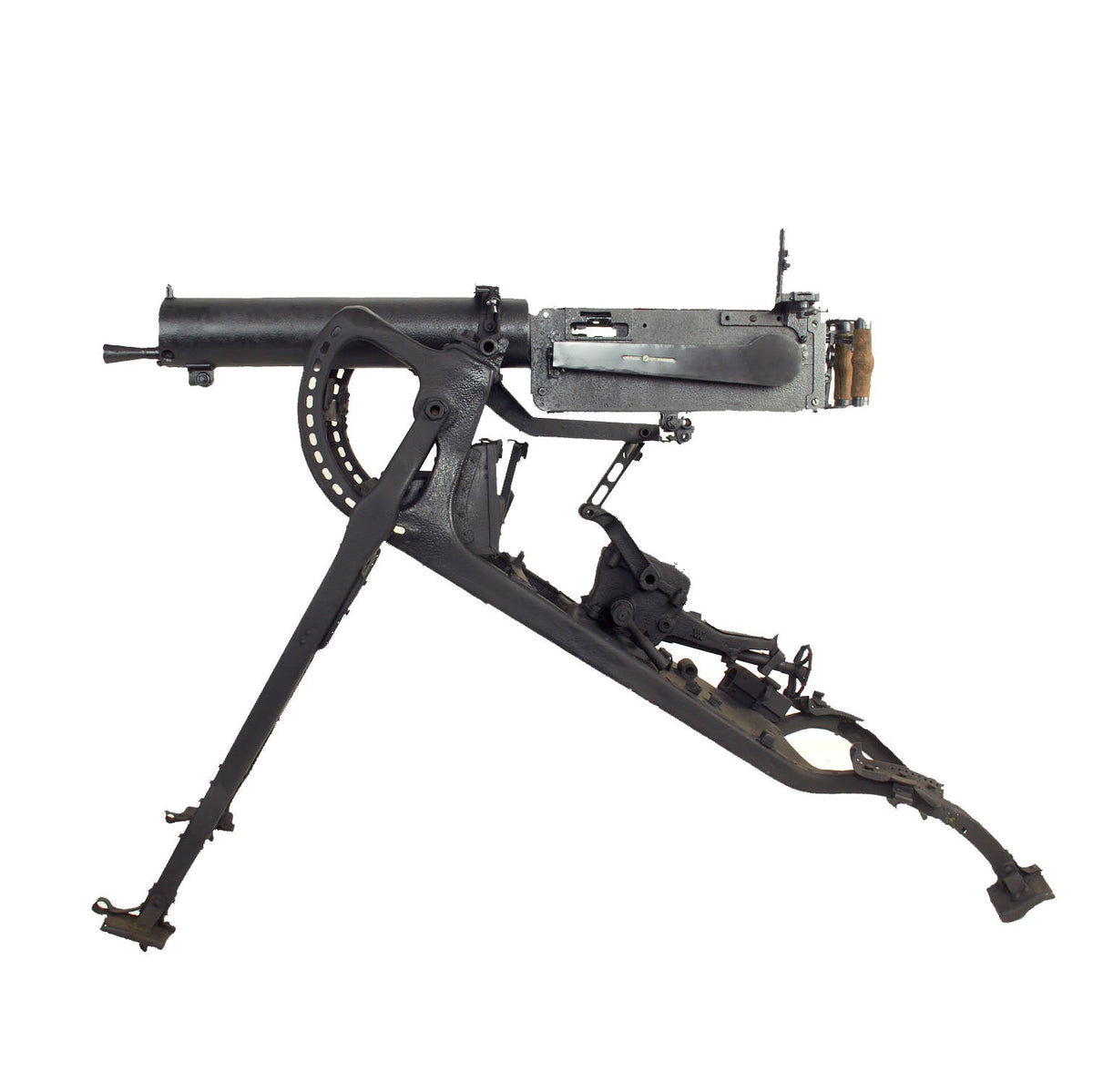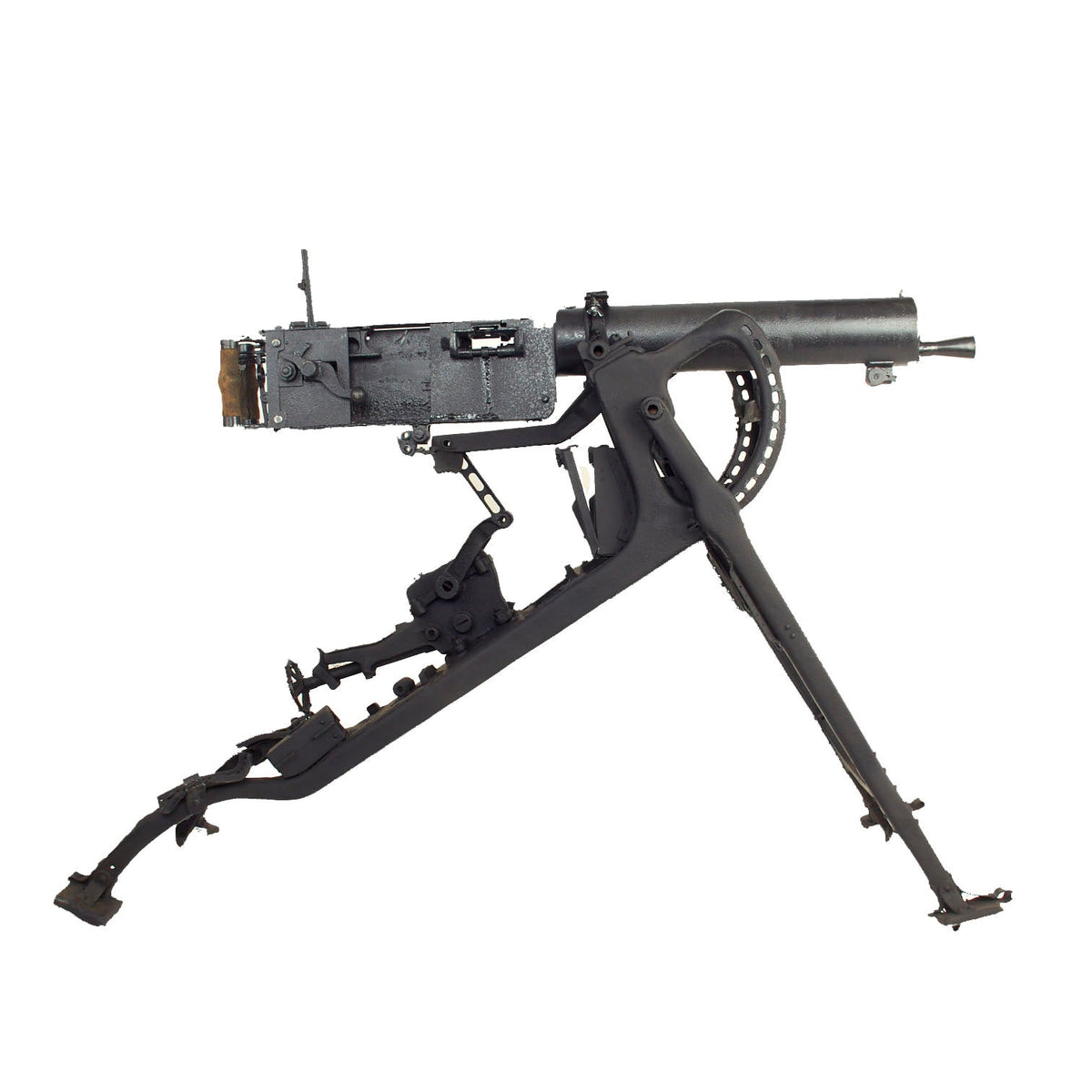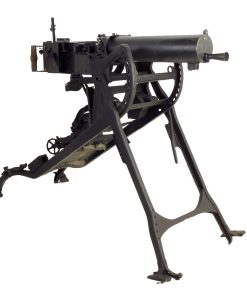Original German WWI 1917 Maxim MG 08 Display Gun by Spandau with Original Sled Mount Original Items
$ 6.995,00 $ 1.748,75
Original Item: One of a kind. Opportunities like this do not come along very often at all, and this may in fact be a once in a lifetime opportunity. German Maxim Maschinengewehr 08 (Machine Gun 08 or MG 08) display guns on original sled mounts are nearly impossible to find on the market. This genuine German WW1 MG 08 water-cooled Maxim machine gun was “The Grim Reaper” of the First World War. We usually on see these once every few years, and now we once again are able to offer one.
The sled mount (Schlittenlafette or “Sled Carriage”) in this fantastic set is all original except for the paint, and is really a good example, as these are often found almost falling apart. It definitely has been exposed to the elements for some time, and the sheet metal portions on front sides rusted through and fell out, most likely years ago. The surface shows light peppered pitting overall, now cleaned away and repainted in lovely gunmetal gray. It still has markings on the top, and has serial number 8279 marked on the upper right edge. As we usually see, the leather and horsehair padding for the knee rests and front legs is completely gone, which often didn’t even survive the war. The metal frames for the pads however are still present, so they could be restored.
The elevation control works, and the elevation release works as well, which allowed the elevation to be set without the fine control. Unfortunately, a lot of the smaller pieces and attachments have rusted away or broken off over the years, such as the clips for the tools, as well as the entire solvent and oil container assembly. The spare barrel holder and both lock boxes are still present, though not entirely functional due to denting and oxidation. The sled mount legs can adjust and fold up as designed, with the right side lever missing the last few inches.
The display gun included in this lovely set is totally inert, having had the right side plate demilitarized to BATF specifications to make it a totally legal non-firing display gun, leaving the right side of the receiver open. In the past, this MG 08 was used as a V.F.W. “Gatekeeper” ornament, apparently kept outside for some time. Obsolete captured armaments from the foreign wars were often distributed to Veteran’s organizations following WWII. It was painted with a very durable U.S. Navy “Haze Blue” finish, but over time even this was unable to protect it, so it did suffer oxidation throughout the exterior and interior.
Prior to this it looks like it already had the lock removed, as well as the barrel and barrel extension to make it “inert”. The muzzle attachment was also removed long ago, and the front opening plugged with lead, which we had to drill out. We have however cleaned and restored it into what is now a very lovely display machine gun. We even added an ORIGINAL LIVE German MG08 barrel to the interior of the barrel jacket, which has an adapted flash hider clamped to the front to make it look great. Due to being outdoors, the wooden grips did suffer exposure damage, but are still actually quite solid. The tops to the oil bottles in the spade grip were for some reason sawn off long ago. The fussee spring cover, made of thin sheet steel, also did not survive, and was replaced with a replica.
Due to the oxidation and repairs the top cover needed, we can no longer make out most of the markings, but we can however still see the location and date:
SPANDAU.
1917.
Spandau Arsenal, known in German as Gewehr und Munitionsfabrik (Gwf.) Spandau during the WWI period, the center for development of military small arms for Imperial Germany from the Industrial Revolution until 1919. They manufactured many long arms during the 19th and early 20th centuries at the their location, which is today part of Berlin.
We looked for serial numbers on the other parts of the gun, and the top cover to the rear of the sight, the feed block, the top cover latch, and the spade grip are all marked with 1010, so this was at least a partially matching machine gun before it was deactivated. The rear of the barrel jacket is marked 7410, so that component had been swapped out at some point. Even with all of the oxidation and weathering, there are still a lot of markings and proofs on this example, typical of WWI German production.
The set comes complete with an ammo box and linked ammo for display. They are not the correct type for the MG08, but they really help with the display potential. Please note that the belt will be omitted if required due to high capacity magazine laws.
It has been over 100 years since of the conclusion of WWI. A terrible conflict that lasted 4 tortuous years and destroyed the manhood of Europe. It only concluded after the entry of the United States in 1917 to tip the scales to the Allies favor ending at the 11th hour on the 11th day of the 11th month in 1918.
With a 1917 date, this gun and most likely the mount were almost certainly used in the conflict. Ready to be the crown jewel of your WWI Collection!
History of the MG 08-
The Maschinengewehr 08, or MG 08, was the German Army’s standard machine gun in World War I and is an adaption of Hiram S. Maxim’s original 1884 Maxim gun. It was produced in a number of variants during the war. The MG 08 served during World War II as a heavy machine gun in many German infantry divisions, although by the end of the war it had mostly been relegated to second-rate fortress units.
The Maschinengewehr 08 (or MG 08)- so-named after 1908, its year of adoption – was a development of the license made Maschinengewehr 01. It could reach a firing rate of up to 400 rounds per minute using 250-round fabric belts of 7.92x57mm ammunition, although sustained firing would lead to overheating; it was water-cooled using a jacket around the barrel that held approximately one gallon of water. Using a separate attachment sight with range calculator for indirect fire, the MG 08 could be operated from cover. Additional telescopic sights were also developed and used in quantity during the war.
The MG 08, like the Maxim gun, operated on the basis of short barrel recoil and a toggle lock; once cocked and fired the MG 08 would continue firing rounds until the trigger was released (or until all available ammunition was expended). Its practical range was estimated at some 2,000 metres (2,200 yd) up to an extreme range of 3,600 metres (3,900 yd). The MG 08 was mounted on a sled mount (German: Schlittenlafette) that was ferried between locations either on carts or else carried above men’s shoulders in the manner of a stretcher.
Pre-war production was by Deutsche Waffen und Munitionsfabriken (DWM) in Berlin and the government arsenal at Spandau (so that the gun was often referred to as a Spandau MG 08).
Fast Shipping with Professional Packaging
Thanks to our longstanding association with UPS FedEx DHL, and other major international carriers, we are able to provide a range of shipping options. Our warehouse staff is expertly trained and will wrap your products according to our exact and precise specifications. Prior to shipping, your goods will be thoroughly examined and securely secured. We ship to thousands clients each day across multiple countries. This shows how we're dedicated to be the largest retailer on the internet. Warehouses and distribution centres can be located throughout Europe as well as the USA.
Note: Orders with more than one item will be assigned a processing date depending on the item.
Before shipping before shipping, we'll conduct a thorough inspection of the items you have ordered. Today, the majority of orders will be delivered within 48 hours. The delivery time will be between 3-7 days.
Returns
The stock is dynamic and we cannot completely manage it because multiple stakeholders are involved, including our factory and warehouse. So the actual stock may alter at any time. It's possible that you may not receive your order once the order has been made.
Our policy is valid for a period of 30 days. If you don't receive the product within 30 days, we are not able to issue a refund or an exchange.
You can only return an item if it is unused and in the same state as the day you received it. You must have the item in its original packaging.
Related products
Uncategorized
Uncategorized
Armoured Fighting Vehicles of the World: AFVs of World War One (Hardcover Book) New Made Items
Uncategorized
Uncategorized
Uncategorized
Uncategorized
Uncategorized
Uncategorized
Uncategorized
Uncategorized
Uncategorized
Uncategorized
Uncategorized
Uncategorized
Armored Burgonet Helmet & Polearm from Scottish Castle Leith Hall Circa 1700 Original Items
Uncategorized
Australian WWII Owen MK1 Machine Carbine SMG Custom Fabricated Replica with Sling Original Items
Uncategorized
Uncategorized
Uncategorized
Band of Brothers ORIGINAL GERMAN WWII Le. F.H. 18 10.5cm ARTILLERY PIECE Original Items
Uncategorized
Uncategorized
Uncategorized
Angolan Rebel 1970s era 60mm Inert Display Mortar from Angolan Civil War Original Items
